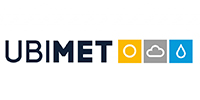
Weather-based sales planning ensures more sustainability and efficiency for retailers
In the ages of climate change and digitisation, precise weather data is increasingly becoming a strategic competitive edge – a factor that more and more often determines a company’s economic success. This is true for retailers when it comes to sales planning and warehouse management, among other things. With precise weather information and historical empirical data on purchasing behaviour, these factors can be calculated better and even be protected with parametric insurance solutions.
Challenge: minimising spoilage of fresh goods
Rain, storms or heat – there’s hardly a risk factor that influences the economy as much as the weather. Eighty per cent of the global economy depends on the weather, according to estimates of the World Meteorological Organisation. Flights are cancelled due to inclement weather and storms, harvest yields drop in response to droughts or excess rain, and work on construction sites is put on hold for weeks at a time when temperatures drop below zero. All of these are scenarios with the potential to cost companies lots of money. It is not just extreme events like flooding and storms that are problematic here; even just an especially wet summer can spoil prospects for seasonal businesses such as beer gardens and outdoor swimming pools.
When working with food retailers, the core question is how to master the ordering process so that warehouse capacity utilisation is optimised and planned with foresight for fresh goods on the one hand, and so that spoilage is minimised but there is still sufficient inventory on the other hand. This balancing act requires more than just short-term predictions; it calls for seasonal forecasts as well. With these forecasts, for example, it is easy to estimate how much fresh meat, fruit, vegetables or dairy products will be needed during a rainy summer.
More than 30 per cent of all fresh items are influenced by the weather, i.e. the sale of these items depends very much on the actual weather conditions or on the weather or temperature forecasts. Mozzarella, for example, has a significant seasonal character. While a medium-sized supermarket branch usually sells between 10 and 30 units of mozzarella per day in the autumn, winter and spring, sales quantities sky-rocket in the summer. On some days over 120 units are even sold. This is one item with sales that fluctuate wildly in the summer months from between 30 and 100 units per day, usually.
Solution: predictive analytics as a planning tool
Funk cooperates with the UBIMET Group in the context of insurance-related weather risks. UBIMET, headquartered in Vienna, specializes in high-precision weather information and system-integrated solutions that enable companies in weather-dependent industries worldwide to increase safety, efficiency and profitability.
Predictive analytics methods can be used to identify relevant forecast and analysis parameters from unstructured data. This includes retailer data with the specific sales data for the day and branch, information on special promotions and the general purchasing frequency at that specific location, plus additional data such as high-resolution historic weather data, which is put into a quantitative relationships with the retailer’s branch data using artificial intelligence. This approach allows for purchasing and warehouse management to be significantly improved. The results reduce error rates in predicting product sales and in the branch environment by 10 per cent on average. One crucial factor is the deep understanding of meteorologists for the characteristics of customer and weather data.
Artificial intelligence (AI)
AI is an umbrella term for software-based applications that replicate the intelligent performance of the human brain – learning, making judgement calls and solving problems. It is essentially based on algorithms for calculating probabilities and detecting patterns in extensive datasets. The most important feature of AI methods is the ability to learn, whereby the application not only makes decisions based on prescribed, memorised examples it has been fed, but is also able to generalise knowledge gained and apply it correctly in practice. Thanks to these methods, AI applications are constantly improving over time and performing the tasks they have been assigned better and better.
The memories of the drought summer of 2019 are still present. Although February 2020 in particular was clearly too wet in Germany, similar trends are currently emerging from persistent high pressure situations as in 2019. Climate change is increasingly influencing the sales markets and ultimately also the product range on offer. This presents retailers with a number of challenges when it comes to making strategic decisions.
For example, the drought in the summer of 2019 led to onions and storable potatoes being exported from Austria to Germany, France and the Benelux countries because harvests there were poorer. As a result, Austria had to import onions from New Zealand and Australia in autumn. The significantly longer transport distances resulted in higher costs and a poorer ecological footprint. Most of the renowned climate models assume, especially in Central Europe, that the number of dry periods in the warm months will continue to increase. Ultimately, the weather and climate-related challenges in the retail sector will increase and the importance of weather forecasting on production and consumption will continue to grow. This means that weather risks will ultimately remain insurable, but not with historical loss data.
Benefit: Consequences of weather risks are insurable
The improved weather forecasting, in connection with satellite data, allows for the development of robust risk models that can increasingly protect against damage due to weather risks using parametric insurance solutions.
Parametric insurance
In the case of parametric insurance, the insurer adjusts claims based on predefined parameters rather than later damage amounts. If a contractually agreed value range is breached as a result of an event, this ‘trigger’ automatically results in an assigned claims payment in response. Any potential deviation of the claims payment from the actual amount of damage incurred remains as the ‘basic risk’. The increasing use of modern sensors and highly developed analysis software has facilitated the constantly improved recording of damage-relevant data flows on the one hand and the development of more reliable models for correlating trigger events and damage amounts on the other.
Using parameters defined in advance, such as the number of rainy or frosty days in a defined period of time, the cover is tailored to the specified needs of the company with the desired insured sums. The defined parameters are then continuously monitored during the insurance duration or risk period. As soon as the defined thresholds are exceeded, the insured company receives the payout within a few days, without the actual amount of damage needing to be verified. In addition to weather-induced loss of earnings and additional costs, damage following classic natural events such as earthquakes, flooding or low water, heavy rain or hail can also be insured using innovative parametric solutions. This approach is even possible in locations with high exposure to risk, where traditional property insurance or general cover may not offer any protection or only limited protection. By combining data and intelligent forecasting with a tailor-made insurance solution, a weather risk can be covered with comprehensive protection.
Your point of contact


Technical aspects
Multiple data sources
Predictive analytics
Artificial intelligence
Benefits/objectives
Weather-optimized purchase & sales planning
Basis for parametric insurance
Transparent claims payment without delay


